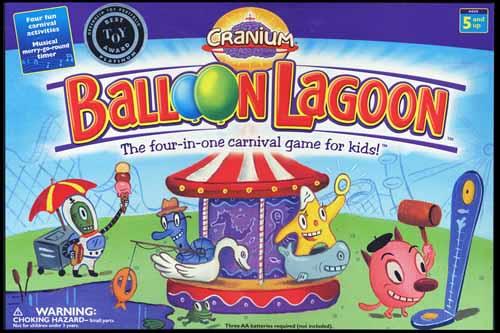
The Basics:
- Ages 5 and Up
(but I think most 4 year olds and some 3 year olds could handle it) - For 2 to 4 players
- About 30-45 minutes to play
(unless you use the house rule mentioned below, which knocks it down to 10 minutes or less)
Geek Skills:
- Counting & Math
- Memorization & Pattern Matching
- Reading & Writing
- Hand/Eye Coordination & Dexterity
- Visuospatial Skills
Learning Curve:
- Child – Easy
- Adult – Easy
Theme & Narrative:
- An aquatic carnival
Endorsements:
- Father Geek approved (but only with the house rule)!
- Child Geek approved!
Overview
In Balloon Lagoon, players are participants at an aquatic “Sea World” type of carnival. They collect balloons by playing different mini-games, and the first player to fill his mover with balloons wins.
Balloon Lagoon is almost more toy than game, but for young geeks, that’s a good thing. The board is assembled by attaching the four mini-game platforms to a large carousel and, when completed, looks kind of like a four-leaf clover. The carousel is a spinner and a timer for the mini-games, and pressing its button starts a whimsical musical ditty that lasts about a minute.
The mini-games themselves are simple but varied. There is a letter game where players fish magnetic letters out of a plastic pond to try to make a word, a dice-tumbling game where players try to collect sets of snacks, a frog-flicking game where players try to get plastic jumping frogs to hop into a pond, and a picture-making game where players try to get 5-sided tumblers to line up and form a given picture.
On your turn, you spin the spinner, move your mover to the game the spinner points to, start the timer, play the game until the music stops, and collect balloons according to how well you did. Then it’s the next player’s turn.
That’s where the flaw of the game comes in. There is nothing to do on the other players’ turns, and an unlucky player could spin the same game every time. There is no player interaction, which is fine in a kids’ game, but it means that that there is no reason to take turns at all.
Instead, we play like this:
- Have every player sit by a different game and then start the timer
- Let all the players play their games at the same time until the timer is up
- Award balloons accordingly
- Finally, everyone rotates one seat (to the left or right) and repeats the above steps
This new turn order eliminates all of the downtime in the game, shortening the play time to 10 minutes or less, and guarantees that each player will play every game at least once.
Mathematically, the most points you can score in any of the games is 4, and it takes 15 balloons to fill your mover, so you will have to play at least 4 games. You will have to handle ties, which aren’t possible when playing by the printed rules, but I’m sure you’ll come up with something. We just let the game end in a tie, but if you want to introduce some kind of “sudden death” rule, go for it.
Final Word
Sometimes a game can have a really brilliant concept or novel component but also have some flaw in its design that makes it about half as fun as it could be. Sometimes that flaw can be easily overcome with a simple house rule. That’s the case with Balloon Lagoon.
While this isn’t the kind of game I’d bring out with my adult gaming group, it is the one my two daughters request the most. The mini games are all fun little activities, and easy enough that my 4-year old doesn’t get frustrated.
I do have a few issues with the components, but they aren’t bad enough to ruin the experience. The magnetic letters in the Letter Lake make it too easy to pull out the entire alphabet subset in 3 easy motions, and it can be difficult to get the balloons to stick in your mover. Other than that, everything works pretty smoothly. I’ve never played it by the printed rules and I can’t imagine that it wouldn’t outstay its welcome that way, but with the variant, it’s an easy win in my book.




Omg thank you for the alternate rules! Life (and sanity) saving tip!
Our pleasure. We often find that changing the rules is unnecessary, but there are a few cases where the game is so much fun to play, we don’t let rules get in the way!